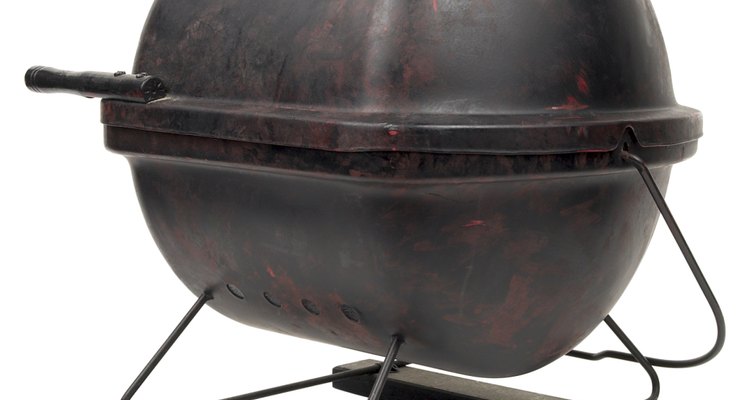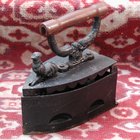
There’s something about kettle and barrel-shaped barbecue grills that symbolizes authenticity. Both shapes are iconic symbols of down-home, Southern-style backyard barbecues. When you see a kettle or barrel-shaped grill, you also categorize the owner as someone who is serious about barbecue and has earned her bragging rights. And when these grills are on the premises, you see bags of charcoal or chunks of wood -- a propane tank will not be around.
Kettle
Kettle grills are portable grills that have a round or oval shape. The round-shaped grills were first introduced by George Weber, a sheet metal worker in Chicago, during the 1950s. Oval-shaped grills were made popular by Ed Fischer, of Atlanta, who invented the green-colored egg-shaped grills, based on ancient Asian clay pot cooking techniques. Round kettle grills are typically made of enamel-coated steel and have a half-circle shape bottom and a removable half-circle shape lid. The grill grate is also round in shape. Oval kettle grills, such as the green egg, are made of enamel-coated cast iron and have flip-top lids and oval-shaped grill grates made of stainless steel. Kettle grills are used to cook foods using direct heat to char-grill foods directly above the flames or by indirect cooking methods to smoke foods, using the “low and slow” cooking method. Kettle and oval grills are fueled by charcoal, wood chunks and chips or by propane.
Barrel
Unlike kettle grills, which came into popularity as the result of an entrepreneurial vision, barrel-shaped grills have humble beginnings. Original barrel-shaped grills began as discarded oil drums, cut in half, welded, hinged and repurposed into barbecue grills. Grill grates were often made of heavy-gauge aluminum screens. Legs and stands for grills were made from pipefittings, upon which the drum would be tilted horizontally. You can still find local artisans who specialize in building custom oil drum grills today. They are popular among barbecue chefs and grillers who like to smoke meats with hickory, apple and mesquite wood. The down-home shape of barrel grills is no longer tied to grills made from repurposed oil drums. Commercial grill manufacturers also offer ready-to-assemble portable barrel-shaped grills for residential use.
Similarities
Kettle and barrel grills are common shapes for at-home barbecue grills among those who prefer charcoal versus gas and propane grilling appliances. They both have a look that’s classic and iconic, and symbolic with at-home grilling occasions. Black is the most common exterior color choice for enamel-coated round-shaped kettle grills, converted oil drums and ready-to-assemble portable barrel-shaped grills. And wood and charcoal are the most common fuels for kettle and barrel-shaped grills.
Differences
Kettle grills are most commonly used by individuals for at-home grilling purposes to feed small gatherings of people. Barrel-shaped grills have a larger grilling surface area. As a result, they can be used for at-home grilling, events, commercial and mobile food-service applications. Extra-large barrel grills have interior firebox chambers large enough to accommodate wood logs in addition to charcoal, wood chunks and chips. Commercial grills are most often wood-fired grills and not fueled by propane.
Related Articles

Dutch Oven Cooking Schools

Difference Between Hibachi & Teriyaki

How to Cook a Pork Chop on a Dome ...

How to Cook in an Electric Frying Pan

The History of Coal Iron Presses

The Advantages of Wok Cooking

Is Revere Ware Aluminum?

How to Cook Barbecue Wings Over ...

Pros & Cons of Mouth Grills

How to Bake With a Pizza Screen

How to Cook Chicken Bratwurst

How to Smoke Hamburgers

What Is a Hibachi Restaurant?

How to Cook Haddock on the Grill

Can You Bake Sliders?
How to Cook Pork Spare Ribs on a ...

How to Cook Beef Tenderloin on a ...

The Difference Between Grill & Griddle

How to Cook With a Gas Tank

How to Season Granite Grill Cooking ...
References
Writer Bio
Cheryl Munson has been writing since 1990, with experience as a writer and creative director in the advertising industry. She holds a Bachelor of Arts in journalism with a focus on advertising from the University of Wisconsin in Madison.
Photo Credits
Hemera Technologies/PhotoObjects.net/Getty Images